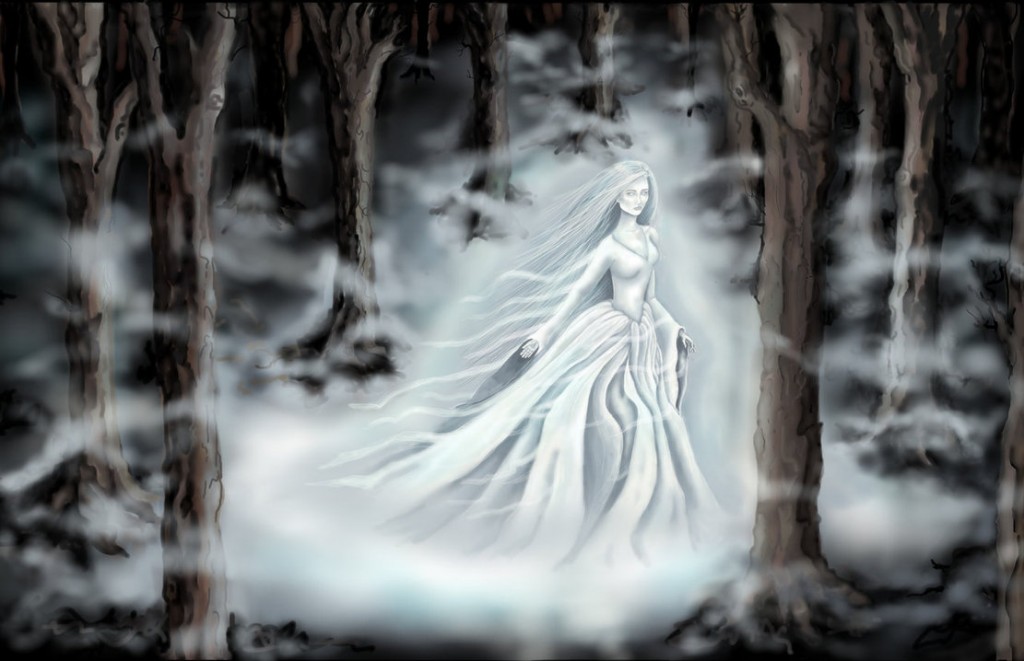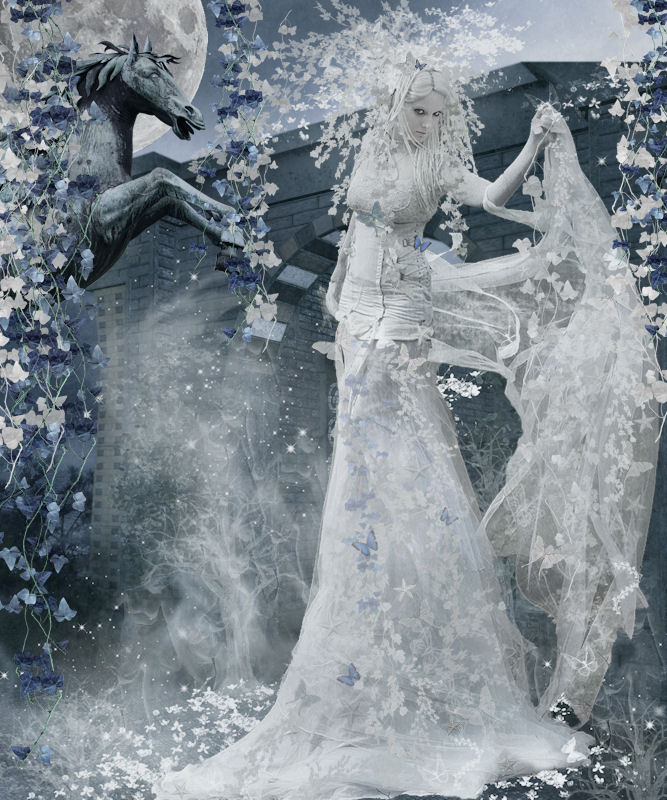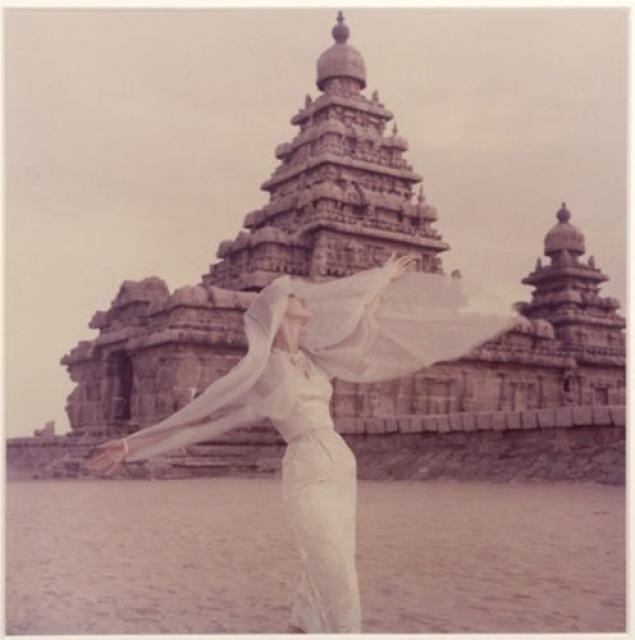LADY IN WHITE, FOREVER TRAPPED
June 17, 2014
A DEEPER LOOK INTO THE MYTH BEHIND LADY SILKWORM
I stand neither in your world nor the other,
but in the fold in between.
To see me wandering the woods, among mulberry trees,
Stone walls veil my face and I am hidden from all.
Poisoned am I with human hope,
Only to glimpse love through the threads I weave.
~My interpretation of Lady Silkworm
Houck’s brilliant imagination captures many exciting (and usually tragic) mythological stories, twists them up and pours them into her books. In TIGER’S VOYAGE, she explores the legend of Lady Silkworm (or Horse-headed Lady) found in Chinese mythology.
China boasts various myths and legends about the origins of silkworms and silk production. One myth is about Cancong, the founder of the ancient Shu kingdom and his contribution of sericulture in local mythology. Another well-known legend is the “Horse-headed Lady”. As the legend goes . . .
“In the dim ages of the past there once was an old man who went on a journey leaving his only daughter and their white stallion. The daughter fed the horse day by day, but she was lonely and yearned for her father.
So it happened that one day she said in jest to the horse: “If you will bring back my father to me then I will marry you!”
No sooner had the horse heard her say this, than he broke loose and ran away. He ran until he came to the place where her father was. When her father saw the horse, he was pleasantly surprised, caught him and seated himself on his back. And the horse turned back the way he had come, neighing without a pause.
“What can be the matter with the horse?” thought the father. “Something must have surely gone wrong at home!” So he dropped the reins and rode back. And he fed the horse liberally because he had been so intelligent; but the horse ate nothing, and when he saw the girl, he struck out at her with his hoofs and tried to bite her. This surprised the father; he questioned his daughter, and she told him the truth, just as it had occurred.
“You must not say a word about it to any one,” spoke her father, “or else people will talk about us.”
And he took down his crossbow, shot the horse, and hung up his skin in the yard to dry. Then he went on his travels again.
One day his daughter went out walking with the daughter of a neighbor. When they entered the yard, she pushed the horse-hide with her foot and said: “What an unreasonable animal you were—wanting to marry a human being! What happened to you served you right!”
But before she had finished her speech, the horse-hide moved, rose up, wrapped itself about the girl and ran off.
Horrified, her companion ran home to her father and told him what had happened. The neighbors looked for the girl everywhere, but she could not be found.
At last, some days afterward, they saw the girl hanging from the branches of a tree, still wrapped in the horse-hide; and gradually she turned into a silkworm and wove a cocoon. And the threads which she spun were strong and thick. Her girl friend then took down the cocoon and let her slip out of it; and then she spun the silk and sold it at a large profit.
But the girl’s relatives longed for her greatly. So one day the girl appeared riding in the clouds on her horse, followed by a great company and said: “In heaven I have been assigned to the task of watching over the growing of silkworms. You must yearn for me no longer!” And thereupon they built temples to her in her native land, and every year, at the silkworm season, sacrifices are offered to her and her protection is implored. And the Silkworm Goddess is also known as the girl with the Horse’s Head.” Article found here.
There is yet another myth that tells of a girl who was out collecting grass for her step-mother and visited “another world” where she stayed with a heavenly creature dressed in white. So the story goes,
“Long ago, in the province of Hangzhou lived a beautiful, capable little girl named Ah-Qiao. When Ah-Qiao was 9 years old, her mother passed away, leaving Ah-Giao and her 4 year old brother alone to her father. Soon the evil stepmother came into the scene. One day, in the dead of winter, stepmother commanded Ah-Qiao to fetch grass for the sheeps. But in the midst of this deep freeze, where would there be fresh grass? Ah-Qiao ran from morning till night, from the streams to the valleys, and found no fresh grass. She was cold and scared. She sat by a rock and wept. Suddenly, she heard a voice,
“To get fresh grass, go to the valley!”
“To get fresh grass, go to the valley!”
“Ah-Qiao lifted up her head and saw a whit- necked bird flying toward the mountains. She stood up, wiped her tears and took follow. The white-necked bird suddenly made a turn and disappeared, but Ah-Qiao was taken aback by the scene ahead of her: there was an old juniper, whose luscious branches were as big as an umbrella. It canopied over the entire area. Ah-Qiao brushed away the branches, made her way around the statuesque tree and saw water flowing through a stream. Beautiful flowers and green grass adorned the banks, looking like a beautiful spring day.
Ah-Qiao proceeded to cut and collect the grass. But unknowingly, she was slowly making her way down stream.
As her basket became filled, she stood up to wipe her forehead. Not far away stood a beautiful lady all dressed in white. She was smiling and waving at her:
Ah-Qiao looked up, in front of her eyes appeared another world! There was a row of houses with white walls and white shingles. In front of the houses was a small grouping of trees, whose glossy leaves were larger than her palms. There were many white clothed ladies. Each of them carried a basket, singing and laughing, picking leaves off those trees.
“Little girl, what a rare guest! Come stay with us for a few days!”
Ah-Qiao was quite pleased with the offer, and decidedly stayed on.
Ah-Qiao made this place her home. She picked leaves during the day and during the nights she fed these leaves to white little caterpillars. Overtime, these caterpillars grew. They spun walnut-like snow-white cocoons. They were silk. The white-clothes ladies taught Ah-Qiao to pull, spin and color the silk threads. These white caterpillars are known as “heaven worms”(天虫). The leaves are mulberry leaves. They made beautiful dresses and gowns out of these silk. These clothes were to be worn by the heaven god and goddesses.
Three months had passed. Ah-Qiao missed her brother dearly. One day at the crack of dawn she took leave, without saying goodbye to the white clothed ladies. But before she left, Ah-Qiao took with her a sheet of freshly laid “Heaven worm” eggs. She also took with her two bagful of mulberry leaves. As she walked on, she threw them onto the ground, marking her trail for next day’s return trip.
Ah-Qiao arrived home and found 15 years had already gone by. Brother and father anxiously inquired Ah-Qiao’s whereabouts. Ah-Qiao told them the whole story. The neighbors heard, and they said she had rendezvoused with the fairies.
The next day morning, Ah-Qiao started to head her way back to the mountain valley. Instead of finding a trail of leaves, she was surprised upon by the fully grown trees. She followed the tree-outlined trail and reached her destination. The old juniper stood the same but she couldn’t find the way in.
As she stood there looking dumbfounded, the white-necked bird flew from behind the tree, and quacked
“Ah-Qiao stole treasure! Ah-Qiao stole treasure!”
It suddenly occurred to Ah-Qiao that she didn’t say her goodbyes to the white-clothed ladies before she left. Not only that, they must also be upset with her for taking the eggs and the mulberry leaves. This was the reason that the roads had become hidden from her.
Ah-Qiao returned home and hatched the eggs and fed them the remaining leaves. She started rearing “heaven worms” in her home.
This was how “Heaven worms” ended up on earth and became domesticated by the humans. The Chinese character, “heaven”(天) when placed above the character “worm”(虫)becomes the character “silkworm” (蚕). Legend has it, that the white clothed lady that Ah-Qiao met with, was the goddess that raised and watched over the silkworms.
She was Lady Silkworm.”
The myth of Lady Silkworm are both tragic and magical. They took root in Colleen’s mind as she wrote TIGER’S VOYAGE and from it, bloomed a delightful new creation of the Lady Silkworm. Here’s an excerpt from chapter 13,
“We caught up with Ren and Kishan and walked into the dark temple together. Its inky gloom was made even denser by the overhanging eaves blocking the moonlight. Kishan turned on his flashlight so we could navigate.
“This way,” Mr. Kadam said, “The inner sanctum would rest directly under the central dome.” We explored the smaller of the two structures and found nothing out of the ordinary. Mr. Kadam pointed to an uncarved rock set in the middle of the room. “This is the murti-the idol, or icon, of the shrine.”
“But it isn’t carved to symbolize anything.”
“An uncarved icon can represent something just as much as a carved one. This room is the garbhagriha, or the womb of the temple.”
“I can see why they call it a womb. It’s dark in here,” I said.
We all stepped to the walls to study the carvings. We’d only been at it a few minutes when I caught a flash of white at the door. I turned my head, but nothing was there. Mr. Kadam said it was time to move to the next shrine. As we passed an arch that opened to the outside, I looked down at the ocean. A beautiful woman, dressed in white with a gossamer veil over her hair, was standing on the shore. She pressed a finger to her lips as she gazed up at me before melting into a nearby mulberry tree.
“Kishan? Mr. Kadam?”
“What is it?” Kishan asked.
“I saw something. A woman, she was standing there. She was dressed all in white, and she looked Indian or maybe Asian. She sort of disappeared by actually, walking inside that mulberry tree.”
Kishan leaned out and scanned the grounds. “I don’t see anything now, but let’s stick together.”
“Okay.”
He took my hand as we walked into the next shrine. We passed Ren, who I hadn’t noticed standing in the darkness behind us. His arms were crossed over his chest in one of his classic “watching me” poses. In the next shrine, I stayed close to Kishan while we scanned the carvings on the wall together. I found a carving of a woman weaving at a loom and traced the outline with my finger. At her foot rested her thread basket, and one of the threads had become unraveled. Curious, I followed its thin line through several more carvings.
The thread was wrapped around the ankle of a farmer, and then a cat toyed with it. The thread trailed on through a wheat field, where I lost it and had to search several carvings before finding it again. It joined a scarf wrapped around a woman’s neck, and then wove itself into a thick rope that blazed with fire. It became a fishing net, it wrapped around a large tree, it tripped a monkey, it was held in a bird’s talong, and then. . .it stopped. It ended at the corner of the room, and, though I searched the adjoining wall, I couldn’t find a place where it continued.
I pressed my thumb against the carved line to feel its texture. It was so thin, my thumb could barely sense it. When I hit the corner at the end of the trail something strange happened. My thumb glowed red-only my thumb- and when I stepped back from the wall, I saw a butterfly crawl out of a crack. It began flapping its wings rapidly, but it didn’t fly. I peered at it closely and realized it wasn’t a butterfly but a large white moth.
It was hairy, almost furry, with large black eyes and some kind of brown feathery antennae that reminded me of the teeth on a baleen whale. When it flapped its wings, something happened to the wall. This small section of wall had been smooth, which was odd because the rest of the wall was covered in detailed carvings.
Thin white lines appeared, and they all radiated from the carved thread I’d been following. They glowed with a light so intense, I had to squint to watch them. When I reached to touch one, the light jumped from the wall to my hand. At the same time, the white lines burst with all the colors of the rainbow. They outlined Phet’s henna design on my hand with white light that quickly began shifting color.
I turned to look back at Kishan, but behind me was only blackness. I couldn’t speak. There was nothing I could do except watch the wall as the lines stretched faster and faster. They were drawing something-a woman, sitting by a window, embroidering. One second I was standing next to the wall, looking at the drawing, and in the next second, the woman breathed and blinked, and I was inside the drawing with her. She was the same woman I’d seen standing on the beach. She was dressed in a white silk gown and wore a gossamer veil over her hair.
She smiled and pointed to the chair across from hers. When I sat, she handed me a circular embroidery frame that had the most lovely stitched version of Durga. The stitches were so small and delicate, that it looked like a painting. She’d created flowers that looked real, and Durga’s hair flowed from her golden cap in waves that looked so soft that I had to touch it. The woman passed across a needle and a small box full of tiny seed pearls.
“What do you want me to do?”
“Durga needs her Necklace.”
“I’ve never sewn with beads before.”
“Look here. . .they have tiny holes. I will show you the first two, and then you can finish it.”
Deftly, she threaded the needle, made the tiniest stitch, slipped a seed pearl onto the needle, tied the thread around it, and inserted the needle back through the fabric. I watched her go through the same process again before she handed the needle to me and placed the box of pearls on the windowsill.
She picked up her frame, selected some blue thread, and continued working. After I’d affixed two beads and was satisfied with my effort, I asked, “Who are you?”
She kept her eyes on her work and answered, “I am called by many names, but the one most commonly used is Lady Silkworm.”
“Durga sent me to you. She said you would help to guide us on our journey.” I blinked. “Oh! You’re from the prophecy. You’re the lady who weaves the silk.”
She smiled while looking at her needle, “Yes. I weave and embroider silk. Once it was all I lived for, but now it is my penance.”
“Your penance?”
“Yes. For betraying the man I loved. . . Many, many years ago, women were admired for their skill in needlework. Girls were trained at a very young age, and those most highly skilled were taken to sew for the emporor. Some, a very few, even became wives for noblemen, and because of their skill, their families were well provided for. At the celebration of every New Year, young girls were chosen to learn this skill. They gather around a bowl of water and dip their fingers in at the edges. A needle is then placed on the surface of the water and spun. When it stops, the girl who the needle points to is taken away for special training in embroidery. . . I was such a child. I was praised as being the most talented worker of the needle in the entire empire, and the designs I created with highly sought after. . . A few years later, at age twenty, I met someone, a handsome young man who worked with silk. His family formed the worms, spun, and dyed the threads, and they were very good, the best in the country. . . I made a point of only ordering from them. I’d been commissioned to make a wardrobe for the future bride of the emperor. . . I was to live at the palace for a year and sew marvelous clothing and a bridal veil for the emperor’s new wife. The prospect was exciting to such a young girl. I was given generous living arrangements near the emperor himself, and I wanted for nothing. . .
The emperor was very selective and his tastes changed every day. He visited me every week to check on my progress. I would only just begin a design, and then he would change his mind. He’d want birds one week, flowers the next, gold one week, then silver and blue, and so on. The man changed his mind more often than he changed his bathwater. Perhaps that was why he took so long to select a bride. . . Over time he made romantic overtures on his visits. Because of the emperor’s eclectic and varied tastes, I became very familiar with the young man who delivered the silk fabrics. . .Sometimes he’d sit and talk with me as I sewed. Soon I began to look forward to his visits, and it wasn’t much later that I started to invent new reasons to have him come. I often found myself daydreaming of him, and my work began to suffer. I lost enthusiasm for the emperor’s projects and attentions. I stared out the window one day when I saw my young man walk across the courtyard. Inspiration struck, and started a new project. I’d never made anything uncommissioned before. It was a gift for my young silkmaker. I couldn’t sleep, so enthralled was I by my task. . . When I gave him his gift, his eyes lit up with surprise and happiness. He carefully opened it and picked up the scarf. Mulberry trees ran down the length of the golden fabric, and silkworm cocoons hung from the branches. White silkworm moths sat on some of the leaves, and silken threads of every hue were wound around a shuttle on either end of the scarf. He told me he’s never been given anything so fine. He told me he’d never been given anything so fine. I confessed that I would give him more. . . if he asked.
He touched me then and said he could not be with me. . . [Because of his station, it could never be for he had not the money with which to offer in exchange for my hand.] . . I tried to accept that we couldn’t be together. Still, I watched for him week after week and as the year passed, we fell deeply in love. . .We made plans to secretly elope as soon as I was finished with the emperor’s commission. When I had finished the veil meant for the emperor’s bride I presented it to him. He lifted it over my head and pronounced that he was now ready to marry his bride. Then he declared that I was to be his bride that very night. . .
I panicked and begged him for another day. . . I sent word to my young man, demanding that rose thread be delivered at once. When he arrived, I wrapped my arms around him and held him close. I explained that the emperor had made plans to marry me and that my father had accepted. I begged him to take me away, quickly, that evening. He made plans to ask for help from someone, a wizard, and advised me to wait for him, that someone would come for me that night and wear the scarf I’d made. He asked me to trust him.”
“What happened?” I asked. “Did someone come?”
“Yes. An ordinary brown plow horse came.”
“A plow horse?”
“Yes. He trotted slowly to my window and neighed softly. He wore the scarf wrapped around his neck.”
“The horse wore the scarf? Where was your young man?”
“I didn’t know. I was frightened. The horse stamped his feet and neighed louder, but I stood at the window, wringing my hands. I didn’t know what to do. The horse became agitated, alerting the guard and men were summoned to take the horse to the stables. The horse kicked and bit until one of the head guards came out and told them to shut the horse up before it woke the emperor. The scarf slipped from around its neck and fell into the mud.
I cried and wondered where my young man was. I despaired thinking he’d been shot or killed on the road. He never came. I watched for him at the window all that night. The next morning the emperor came to me and had me escorted to a bathing chamber. I was bathed and dressed in the beautiful clothes I had made, and just before I was led into the great hall, the emperor came into my chamber, sent out the servants, and closed the door behind him. ‘I have a wedding present for you, my dear.’ He handed me the scarf I’d given to my young man. It had been cleaned and pressed but many of the delicate stitches were torn.
Tears fell down my face. He said that an interesting incident had occurred last night. ‘It seems a plow horse entered the palace grounds wearing this very scarf. He was locked away in the stables but by next morning, to our surprise, we found not a horse but the silkmaker in the stall. We asked him what magic he used and why he’d come. He won’t speak. He refuses to share his reason for infiltrating my palace in the middle of the night. I can only assume he came to assassinate me. How fortunate you are that your husband-to-be is safe.’ Before I could guard my words, I exclaimed that he didn’t come to assassinate him. The emperor was not a fool. He quickly learned of our love for each other. Then he called me to the window overlooking a courtyard. My dear love was tied to a post, while a man stood nearby with a whip. The emperor raised and lowered his hand abruptly. I heard the whip snap in the air and whimpered as if I too could feel the burn of the lash as it tore across the back of my love.
The emperor whispered coldly, ‘Did you think I wouldn’t recognize your handiwork, my dear? You have bestowed your favor on this man.’ I begged him to not hurt him. He said, ‘You can stop his torture whenever you wish. Just tell me that I’m mistaken and that this young man did not come for you. That all of this is just a simple misunderstanding. And . . say it loudly so that all may hear.’ I heard the groan of the one I loved and turned to the emperor, ‘This young man-‘ “‘Louder, please. And make sure everyone outside can hear you as well.’ “‘This young man did not come for me, and I do not love him.’ . . My loves looked at me and his eyes burned with my betrayal. I wanted to shout that it was all a lie, that I only wanted to be with him, but I kept silent, hoping to save his life. “‘That is all I needed to hear,” said the emperor. He shouted down to the men, ‘Put him out of his misery.’
“They raised their bows and filled my love’s chest full of arrows. He died believing that I didn’t care for him. I fell to the floor in despair while the emperor threatened that I remember this lesson and to compose myself for the wedding. I wept bitterly. If only I had trusted what I did not understand. He had been the horse all along. I just refused to see it. Because I was shortsighted, I lost everything.
Later, a kind woman rested her hand on my shoulder and dried my tears with her silken handkerchief. She said she loved my work and that my gifts could still be used to benefit others. That woman was Durga. She offered to take me away, to help me escape from the emperor, but said that I could never return to a mortal life. She picked up his golden scarf from where I’d dropped it and told me that my silkmaker would always be near, for I had sewn love into each stitch.
So here I sit. I am Lady Silkworm. Still wrapped in my cocoon of sorrow. Stitching, always stitching. I sew to bind others, but I remain alone. I tie threads together to give my existence meaning, to have a purpose. It does give me some happiness t help others weave their lives together.” She leaned forward, “But I will tell you now, young one, without your love-life is nothing. Without your mate, you are utterly alone.” She dropped her frame and grasped my hands.
“Above all else, I beg you to trust the one you love.”
She picked up my finished work from my lap. “There now. You see? you did an excellent job.” She smiled, “It’s time for you to return. Take this with you.”
She slipped the fabric she’d been embroidering from its frame, carefully folded it, and pressed it into my arms. “But I-“
She shushed me with a look and guided me to the wall. Lifting a delicate hand, she traced her finger across a carved thread. “I cannot speak of this anymore today. The sadness is too great. It is time for you to leave. Follow the silkworm, young one.”
She cupped her hand against the wall, and when she removed it, a white silkworm clung to the carved thread. As it began advancing along the line, I turned to say good-bye, but Lady Silkworm had disappeared. The worm made slow progress to a crack in the wall and then slipped inside. I tentatively touched the same crack. First my fingers and then my whole hand disappeared into the wall. Taking a deep breath, I stepped forward to find myself encompassed by blackness.”
I love how Houck’s story always leaves me wanting more. She seamlessly transports me to a magical and enchanting new world and I just can’t wait for her new novel to hit the shelves in 2015!!
If there’s something from Colleen’s works you’d like the inside scoop on whether it’s a mythical creature, story, character, or place, give a shout out and leave a comment. We will be featuring something related to this very topic once a month as possible.
~ Hope you enjoyed this blog and until next time,
Linda Louise Lotti
This entry was posted in Articles, Tiger's Voyage.
Categories
- A Guy's Perspective
- Articles
- Beauty
- Bonus Material
- Colleen Houck Book Club
- Conferences
- Contest
- Contest Winners
- Crafts
- Events
- Exclusive
- Fans
- Featuring Authors
- Grandma's Review
- Holidays
- International Books
- Kelsey's Favorite Things
- Kid's Perspective
- Life Events
- Marketing
- Marketing
- Movie
- Movie Review
- Mr. Kadam's Spice Kitchen
- Mythology
- News
- Puzzle
- Quizzes & Games
- Reawakened
- Recipes
- Recreated
- Reignited
- Reunited
- Shows
- store
- Terraformer
- The Lantern's Ember
- The Modern Ink Society
- Tiger's Curse
- Tiger's Destiny
- Tiger's Dream
- Tiger's Promise
- Tiger's Quest
- Tiger's Tale
- Tiger's Voyage
- Top Ten Lists
- Travel
- Uncategorized
- Upcoming YA Books
- Valentine's Day
- Video
- Writing Advice
- Writing Fun
- Writing Tools
- YA Scavenger Hunt
Archive
- November 2020
- September 2020
- July 2020
- June 2020
- May 2020
- April 2020
- March 2020
- October 2019
- September 2019
- June 2019
- May 2019
- April 2019
- March 2019
- January 2019
- December 2018
- November 2018
- October 2018
- September 2018
- August 2018
- July 2018
- May 2018
- April 2018
- March 2018
- February 2018
- January 2018
- December 2017
- October 2017
- September 2017
- August 2017
- July 2017
- June 2017
- May 2017
- April 2017
- March 2017
- February 2017
- January 2017
- December 2016
- November 2016
- October 2016
- September 2016
- August 2016
- July 2016
- June 2016
- May 2016
- April 2016
- March 2016
- February 2016
- January 2016
- December 2015
- November 2015
- October 2015
- September 2015
- August 2015
- July 2015
- June 2015
- May 2015
- April 2015
- March 2015
- February 2015
- January 2015
- December 2014
- November 2014
- October 2014
- September 2014
- August 2014
- July 2014
- June 2014
- May 2014
- April 2014
- March 2014
- February 2014
- January 2014
- May 2013
- November 2010
- October 2010
- August 2010
- June 2010
- May 2010
- March 2010





